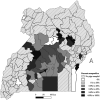Detection of antibodies against Ornithodoros moubata salivary antigens and their association with detection of African swine fever virus in pigs slaughtered in central Uganda
- PMID: 38605921
- PMCID: PMC11007201
- DOI: 10.3389/fvets.2024.1328040
Detection of antibodies against Ornithodoros moubata salivary antigens and their association with detection of African swine fever virus in pigs slaughtered in central Uganda
Abstract
Introduction: African swine fever (ASF) is an important disease of pigs in sub-Saharan Africa and Uganda and is threatening the pig population and agricultural economy of other continents. ASF virus (ASFV) can be transmitted from wild suids to domestic pigs through soft ticks of the Ornithodoros species. The aim of this study was to understand the relationship between domestic pigs' O. moubata tick exposure and ASFV status.
Methods: Pigs were sampled from six abattoirs in the Kampala metropolitan area of Uganda from May 2021 through June 2022. Blood, serum, and tissue samples were collected. Serum was tested for antibodies against the rtTSGP1 salivary antigens of O. moubata ticks using an indirect ELISA assay. Blood and tissue samples from pigs were tested to detect ASFV using qPCR. Probability of tick exposure was categorized based on sample-to-positive ratio cut-off points.
Results: Out of 1,328 serum samples tested, there were 828 (62.3%) samples with a negligible probability; 369 (27.8%) with a medium probability; 90 (6.8%) with a high probability, and 41 (3.1%) with a very high probability of exposure to the O. moubata salivary antigen. There was a statistically significant association between the pigs' O. moubata exposure and ASFV status with a higher proportion of pigs having a very high probability of infection if they were ASFV positive by blood, tonsil, and lymph nodes.
Discussion: These results suggested that tick exposure was associated with ASFV transmission in Uganda. There were ASFV qPCR positive pigs that had no O. moubata exposure as well, which highlights that pig-to-pig and indirect contact transmission still play a significant role. This work highlights the need for further work in Uganda to investigate these transmission factors related to the O. moubata tick and ASFV transmission.
Keywords: African swine fever virus; Ornithodoros; Uganda; swine; transmission.
Copyright © 2024 Kayaga, Wampande, Ekakoro, Okwasiimire, Nassali, Ochoa, Hauser, Ndoboli and Havas.
Conflict of interest statement
The authors declare that the research was conducted in the absence of any commercial or financial relationships that could be construed as a potential conflict of interest.
Figures

References
-
- EFSA Panel on Animal Health and Welfare (AHAW) . Scientific opinion on geographic distribution of tick-borne infections and their vectors in Europe and the other regions of the Mediterranean Basin. EFSA J. (2010) 8:1723. doi: 10.2903/j.efsa.2010.1723 - DOI
-
- EFSA Panel on Animal Health and Welfare . Scientific opinion on the role of tick vectors in the epidemiology of Crimean-Congo hemorrhagic fever and African swine fever in Eurasia. EFSA J. (2010) 8:1703. doi: 10.2903/j.efsa.2010.1703 - DOI
-
- Calisher CH, Fenner FJ. 13—macroecology and microecology of viruses of terrestrial mammals In: Hurst CJ, editor. Viral Ecology. San Diego: Academic Press; (2000). 493–517.
LinkOut - more resources
Full Text Sources

